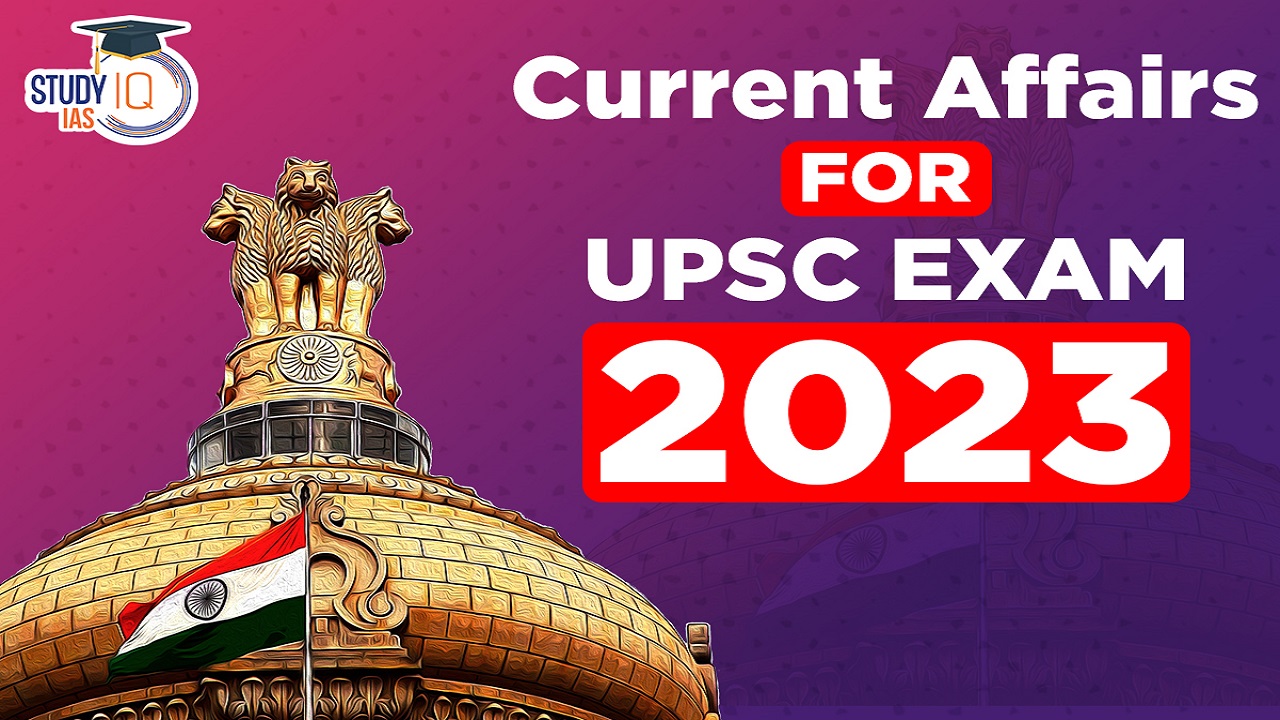Current Affairs 6th June 2023 for UPSC Prelims Exam
Certifying Organic Cotton using AI
Context: European Space Agency (ESA) and Global Organic Textile Standard (GOTS) will collaborate to certify organic cotton in India.
More on the news:
- The collaboration will involve combining data from satellite images and analyzing it through artificial intelligence (AI).
- The initiative will automatically classify cotton fields in India in line with cultivation standards.
- During a pilot study, the model has showed 98% accuracy in differentiating between organic cotton fields and conventional ones.
Methodology:
The first step is to train AI models to ‘read’ ESA satellite data to identify and classify cotton fields in India. After training, the AI model will be able to identify if cotton field has been farmed organically.
Significance of the method:
- It is a risk-free method for organic cotton certification and prevent fraud from the beginning of the supply chain.
- It will help in generating accurate estimates of organic cotton yields in specific regions.
- It will help bring genuine small-scale farmers into the certified organic supply chains, creating new economic opportunities for them.
Global Organic Textile Standard (GOTS)
- GOTS is an alliance of four organizations — Organic Trade Association (US), the Internationaler Verband der Naturtextilwirtschaft (Germany), The Soil Association (U.K.) and the Japan Organic Cotton Association (Japan).
- GOTS brings together the textile and organic industries to promote organic textiles.
Cotton in India:
- India is the largest producer of cotton, accounting for around 25% of the total global cotton production. It is also the 2nd largest consumer of cotton in the world.
- India is the country to grow all four varieties of cultivated cotton.
- Being one of the largest contributors to India’s net foreign exchange, it has been dubbed as ‘white gold’.
- Growing areas: About 67% of India’s cotton is grown on rain-fed areas and 33% on irrigated areas.
- The states of Gujarat, Maharashtra, Telangana, Rajasthan, Karnataka, Andhra Pradesh, Haryana, and Punjab are the largest cotton producers.
Current Affairs 5th June 2023 for UPSC Prelims Exam
OPEC+
Context: The OPEC+ group of oil producers have agreed on a new oil output deal.
What is OPEC+?
- OPEC+ is a group of 23 oil-exporting countries which meets regularly to decide how much crude oil to sell on the world market.
- These nations aim to work together on adjusting crude oil production to bring stability to the oil market.
- At the core of this group are the 13 members of OPEC which are mainly Middle Eastern and African nations.
- It comprises 13 OPEC countries plus Azerbaijan, Bahrain, Brunei, Kazakhstan, Russia, Mexico, Malaysia, South Sudan, Sudan, and Oman.
- Together, OPEC+ nations produce about 40% of all the world’s crude oil.
OPEC:
- The Organization of the Petroleum Exporting Countries (OPEC) is a permanent, intergovernmental Organization.
- It was created at the Baghdad Conference in 1960, by Iran, Iraq, Kuwait, Saudi Arabia and Venezuela.
- OPEC’s objective is to:
- Co-ordinate and unify petroleum policies among Member Countries to secure fair and stable prices for petroleum producers.
- Ensure efficient, economic and regular supply of petroleum to consuming nations.
- Currently, it has 13 members, including Algeria, Angola, Congo, Equatorial Guinea, Gabon, Libya, Nigeria, and the United Arab Emirates.
- Today, OPEC nations produce around 30% of the world’s crude oil.
- Saudi Arabia is the largest oil producer within the cartel, producing more than 10 million barrels a day.
- It is headquartered in Vienna, Austria.
Draft Delhi Declaration on Cyber Security
Context: Recently, India’s National Cyber Security Coordinator has proposed a “Delhi Declaration” for G20 nations.
About Delhi Declaration
- Aim: Promoting cyber peace and cooperation.
- To enhance global cybersecurity cooperation and reinforce responsible state behaviour in cyberspace.
- Objective: To promote cyber peace and cooperation in preventing, mitigating, and investigating cyber incidents in cyberspace.
- It underscores the importance of protecting critical infrastructure, cooperating in preventing cyber incidents, respecting international law, and strengthening the cybersecurity of the humanitarian sector.
- It will be further deliberated upon and considered by G20 nations as part of their efforts to address cyber threats and promote cyber peace.
About National Cyber Security Coordinator (NCSC)
- It is a office under National Security Council Secretariat (NSCS), which coordinates with different agencies at the national level for cyber security matters.
- Mandate: To advise this Council in overseeing and compliance of all the cyber security aspects including implementation of action plans in cyber security by the nodal agencies, evaluation and analysis of incidents, then forming incident response monitoring teams.
- Engage with the private industry for formulation of policies.
- There’s an aspect of international forums and providing consultation and guidance to state governments
Thermal Stratification
Context: Recently, J&K government has attributed the death of thousands of fish in the Dal Lake in Srinagar to “Thermal Stratification”.
- Pollution has badly affected the Schizothorax fish harvest and has destroyed the breeding grounds of the native fish.
- This impact has been very severe since 2007-08 and had a tremendous effect on the total fish production in the Dal Lake.
About Thermal Stratification
- Thermal stratification occurs when the water in a lake forms distinct layers through heating from the sun.
- When the ice has melted in the spring, solar radiation warms the water at the surface of the lake much faster than in deeper waters.
- Since, sunlight often only penetrates a few metres into the lake, directly warming just the top few metres.
- As the water warms, it becomes less dense and remains at the surface, floating in a layer above the cooler, denser water below.
- There are three kinds of thermal stratifications.
- Epilimnion: The upper layer of warmer water.
- Metalimnion: The middle layer with a zone of gradual decrease in temperature.
- Hypolimnion: The bottom layer of colder water.

Mechanism of Thermal Stratification
- Difference in temperature of water at different depths results in thermal stratification in deep water bodies.
- During summer, temperature is higher on the surface water, whereas in lower layer temperature is low.
- During winter in a temperature lake, water is at freezing temperature on the surface, whereas in the lower layer temperature is about 4°C.
- The surface water is cooled during autumn and warmed in spring. This results in a free mixing of water in the whole water body, also known as autumn and spring turnover.
- During spring and autumn due to turnover of water oxygen and nutrients are redistributed, resulting in a bloom of phytoplankton growth while during winter and summer, growth of phytoplankton is low due to low nutrients and oxygen availability.

Dudhwa National Park
Context: Recently, carcass of a two-year-old tigress was recovered from the buffer zone of the Dudhwa Tiger Reserve.
About Dudhwa National Park
- The Dudhwa National Park, also known as the Dudhwa Tiger Reserve, is located in the districts of Lakhimpur and Kheri in the Indian state of Uttar Pradesh.
- This region comes under the sub-Himalayan area called as Terai belt.
- This Terai region is acknowledged as the most endangered ecosystems throughout the world.
- The park is also lying nearby the Indo-Nepal boundary.
- Dudhwa being spread over an expanse of approximately 811 sq km of marshes, grasslands and dense forests.
- It is an ideal and protected home for over 38 species of mammals, 16 species of reptiles and numerous species of birds.

- Composition:
- Dudhwa National Park through which Suheli and Mohana streams flow,
- Kishanpur Wildlife Sanctuary through which Sharda River flows, and
- Katarniaghat Wildlife Sanctuary through which Geruwa River flows.
- All of these rivers are tributaries of the Ghagra River.
- Wildlife: Of the nearly 1300 birds found in the Indian subcontinent, over 450 species can be seen in Dudhwa Reserve.
- Tiger, Rhinoceros, Swamp deer, Elephant, Sambar, Hog deer, Cheetal, Kakar, Wild pig, Rhesus monkey, Langur, Sloth bear, Blue bull, Porcupine, Otter, Turtles, Python, Monitor lizard, Mugger, Gharial etc.
- It is the only place in U.P. where both Tigers and Rhinos can be spotted together


 DRDO and Air Force Successfully Test Ind...
DRDO and Air Force Successfully Test Ind...
 IB ACIO Recruitment 2025 Notification Ou...
IB ACIO Recruitment 2025 Notification Ou...





















